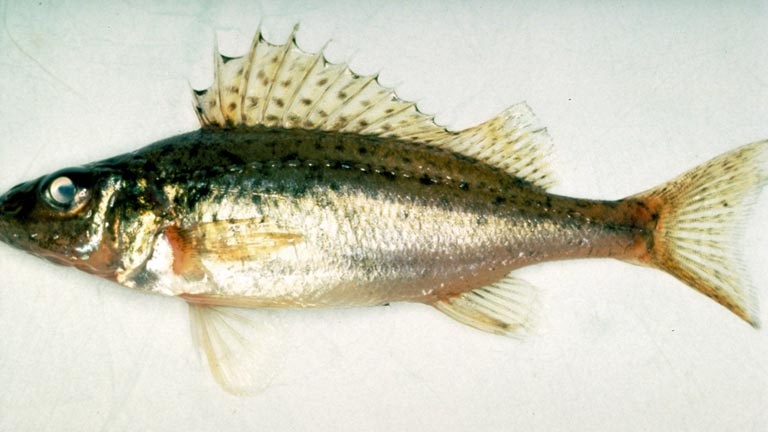Meet the ruffe, aggressive fish causing concern in the St. Marys River
A warning about an aggressive species that has been lurking in the waters of the Great Lakes, even though it’s not very big.
The Eurasian ruffe has recently been detected in the St. Marys River, outside of Sault Ste. Marie, and it’s making its way south causing concern among researchers.
 Eurasian ruff (Gary Cholwek, U.S. Geological Survey, Bugwood.org)
Eurasian ruff (Gary Cholwek, U.S. Geological Survey, Bugwood.org)
"The Eurasian Ruffe is a small, freshwater fish and it’s a member of the perch family, so it’s native to Europe and Asia but it’s suspected to have been transported to North America, specifically Lake Superior, in the ballast water of ships arriving from Europe back in the mid-1980s," said Sydney Currier of the Invasive Species Centre.
"Its spread within the Great Lakes is likely due to heavy ship traffic between Lake Superior and other Great Lakes ports."
In the United States, ruffe has been found along the southern shore of Lake Superior, Lake Michigan and Lake Huron.
In Ontario, it’s been recorded near Thunder Bay and it’s spreading east along the northern shores of Lake Erie with Sault Ste. Marie being the latest place to detect it.
- Download the CTV News app now
- Get local breaking news alerts
- Daily newsletter with the top local stories emailed to your inbox
"They’ve been around, but, now, they’re on the move and they’re going south," Currier said.
"The concern with ruffe is that they’re very aggressive competitors with our native fish, particularly our native sport fish. We’re talking yellow perch and walleye in particular because they compete with those sport fish for food and habitat and they also prey heavily on their eggs and the juveniles of those species. So this is really important from an economic and social point of view given those species and their importance to recreational fishing."
Eurasian ruffe are only about six inches long and they have a perch-like body, but what sets them apart is their sharp dorsal fin and the appearance of it looking like two phones. The fish also doesn’t have any scales on its head.
Currier said anglers are important and will be the first line of defence in keeping Eurasian ruffe from spreading.
"If you see a ruffe in the water or you catch one, it’s really important to take a picture, note the date and the location where you found it at and then don’t return it to the water. Call the invading species hotline and then kill the fish and put it in the garbage," she said.
The Invasive Species Centre said the number one thing anglers can do is know how to spot the ruff and make sure to drain their bilge and dry the boat when taking it in and out of water.
It is illegal to use ruffe as bait.
CTVNews.ca Top Stories

Pakistani citizen arrested in Canada, charged with plotting terrorist attack in New York
A Pakistani citizen who resided in Canada has been charged with plotting a terrorist attack at a Jewish centre in New York City.
Assembly of Manitoba Chiefs Grand Chief Cathy Merrick dies after collapsing outside Winnipeg courthouse
The Grand Chief of the Assembly of Manitoba Chiefs has died after collapsing outside of the Manitoba courthouse Friday afternoon, according to multiple sources.
Woman who was denied a liver transplant, after review highlighted alcohol use, has died
Questions are being raised about the case of a 36-year-old Ontario woman who died of liver failure after she was rejected for a life-saving liver transplant after a medical review highlighted her prior alcohol use.
Montreal man given $664 fine for tying dog to parking meter while grabbing a croissant
A Montreal man who tied his dog to a parking meter while he entered a bakery is now facing a hefty fine for breaking a law he had no idea existed.
Canada-wide warrant issued for woman in fatal Toronto shooting
A 36-year-old woman is wanted for first-degree murder following a shooting near an after-hours club in Toronto earlier this month.
Molson Coors ends diversity, equity and inclusion policies, moves to 'broader view'
Brewing company Molson Coors says it is dropping its diversity, equity and inclusion policies and taking a 'broader view' in which all employees know they are welcome.
Selena Gomez is a billionaire
Selena Gomez can now add becoming a billionaire to her long list of achievements.
Teen girl charged with attempted murder after student set on fire at Saskatoon high school
A 14-year-old girl faces an attempted murder charge after a 15-year-old girl was doused in a flammable substance and set on fire at a Saskatoon high school Thursday.
Victim of Vancouver stranger attacks had surgery to reattach severed hand: police
The surviving victim of a pair of stranger attacks in downtown Vancouver on Wednesday has undergone surgery to reattach his hand after it was severed in the assault, according to police.
































